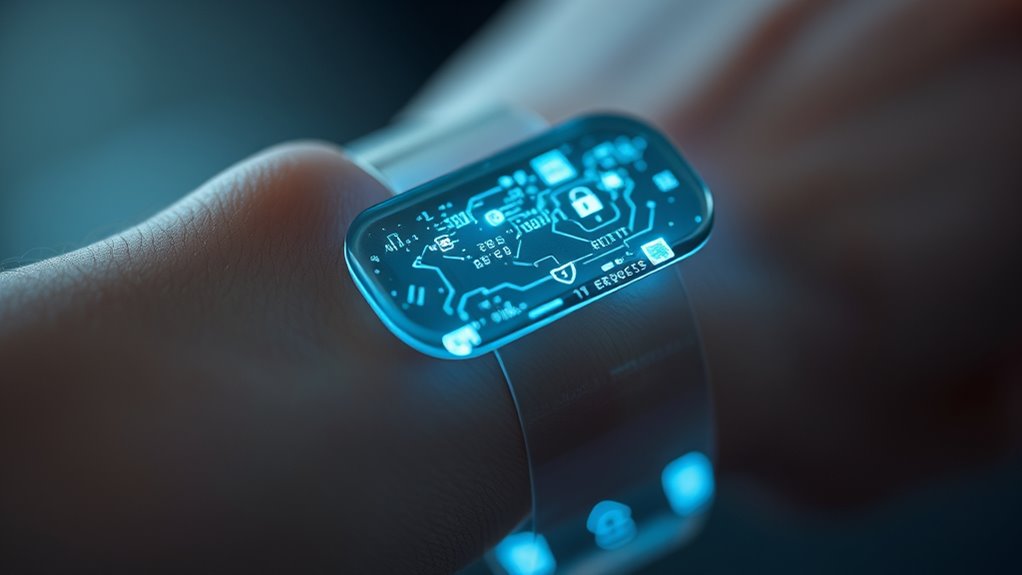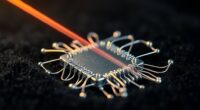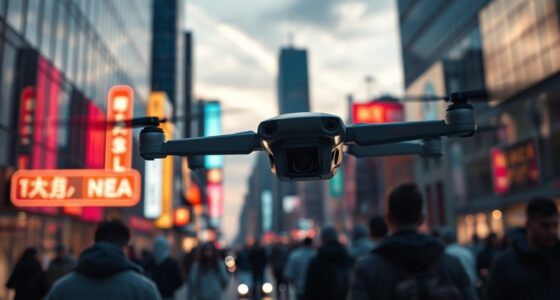In wearable nano sensors, protecting your bio-privacy is essential because they collect sensitive health data like heart rate and blood glucose levels. To keep your information safe, manufacturers must use strong encryption, provide clear privacy policies, and let you control how your data is shared. Regular updates and transparency help build trust and reduce privacy risks. If you want to understand how your health data can stay private and secure, keep exploring this important topic.
Key Takeaways
- Implement robust encryption protocols to secure sensitive health data during collection, transmission, and storage.
- Obtain clear, informed user consent and provide options to control data sharing and privacy preferences.
- Maintain transparency through regular updates on privacy policies, security measures, and data handling practices.
- Ensure manufacturers adhere to vetted security standards to build user confidence in bio-privacy safeguards.
- Promote active user involvement in privacy management to protect health data and uphold bio-privacy rights.

How secure is your personal health data when you wear nano sensors? As these tiny devices become more common in monitoring your health, concerns about privacy naturally arise. Nano sensors collect a vast amount of sensitive information—from your heart rate to blood glucose levels—which makes safeguarding that data essential. One of the key ways to protect your privacy is through robust data encryption. When your health data is transmitted from the nano sensors to your healthcare provider or stored in the cloud, encryption acts as a barrier, scrambling the information so that only authorized parties can decode it. Without proper encryption, malicious actors could intercept your data, leading to potential misuse or identity theft. Consequently, it’s imperative that manufacturers prioritize strong encryption protocols and regularly update them to fend off evolving cyber threats.
But encryption alone isn’t enough. You also need to be actively involved in deciding how your data is used. That’s where user consent plays a critical role. When you first start using wearable nano sensors, read the privacy policies carefully. Companies should clearly explain what data they collect, how they plan to use it, and who they might share it with. By granting informed consent, you retain control over your personal health information. It’s your right to decide whether your data is shared with third parties, used for research, or stored for future analysis. If you’re uncomfortable with certain uses, you should have the option to opt out or restrict access. This layer of control helps guarantee your bio-privacy isn’t compromised without your knowledge or approval.
Your control over data use depends on informed consent and privacy choices.
Moreover, ongoing transparency from manufacturers about data handling practices is essential. They should regularly update users about any changes in privacy policies or security measures. As a user, you should also be vigilant—regularly reviewing permissions and setting privacy preferences on your devices. When both data encryption and user consent are prioritized, you create a safer environment for your personal health data. This collaborative approach empowers you to participate actively in protecting your bio-privacy.
Additionally, understanding the importance of Vetted security standards in these technologies can further enhance your confidence in data protection. Ultimately, the combination of advanced technical safeguards like encryption and your active involvement through informed consent can considerably reduce risks. Wearable nano sensors hold remarkable potential for improving health management, but only if your privacy is respected and protected. By understanding how your data is secured and taking control of your consent, you guarantee that your health journey remains private and safe. Remember, safeguarding your personal health data isn’t just a technical issue—it’s about respecting your rights and maintaining trust in the technology designed to serve you.
Frequently Asked Questions
How Are Wearable Nano Sensors Powered Without Compromising Privacy?
You can power wearable nano sensors through energy harvesting, which captures ambient energy like light or movement, eliminating the need for batteries. To protect your privacy, device manufacturers implement robust privacy protocols, ensuring data remains secure and only accessible to authorized users. This combination allows your sensors to operate efficiently without risking privacy breaches, giving you peace of mind while benefiting from continuous health monitoring.
What Are the International Legal Standards for Nano Sensor Data Privacy?
You need to follow international regulations like GDPR and HIPAA, which set standards for data privacy and security. These laws emphasize data sovereignty, meaning your biometric data must stay within your country’s jurisdiction unless explicitly consented to for transfer. Compliance guarantees your wearable nano sensor data remains protected across borders, safeguarding your privacy while enabling responsible data sharing and usage worldwide.
How Can Users Control Their Data Sharing Preferences Effectively?
You can control your data sharing preferences effectively by actively managing your settings and understanding your rights. Make sure to give clear user consent before sharing any information, and look for options to customize what data you share. Additionally, confirm your data is protected through data encryption, which safeguards your personal information from unauthorized access. Regularly review your preferences to stay in control of your bio-privacy.
What Are the Potential Health Risks of Long-Term Nano Sensor Use?
Long-term nano sensor use could expose you to nano toxicity, potentially harming your cells or tissues. You might also face data security issues if sensitive health information is mishandled or hacked. These risks highlight the importance of monitoring nano safety and ensuring robust data protection measures. Staying informed and advocating for strict safety protocols can help minimize health risks and protect your personal data over time.
How Does Bio-Privacy Impact Future Wearable Sensor Innovations?
Your future wearable sensors could become unstoppable data vaults, making bio-privacy more vital than ever. You’ll need rock-solid data encryption to shield your personal info from hackers, and clear user consent to guarantee your rights are protected. Without these safeguards, innovations might hit a wall, risking privacy breaches that could deter you from embracing cutting-edge health tech. Prioritizing bio-privacy keeps your data safe and encourages ongoing innovation.
Conclusion
As you embrace wearable nano sensors, remember that safeguarding your bio-privacy is essential, just like locking a treasure chest in a pirate’s tale. With evolving technology, you hold the key to controlling your personal data’s fate. Stay vigilant, set boundaries, and advocate for transparent practices. By doing so, you guarantee your health journey remains private, secure, and future-proof—protecting your digital self in this brave new world where privacy is your most precious cargo.









